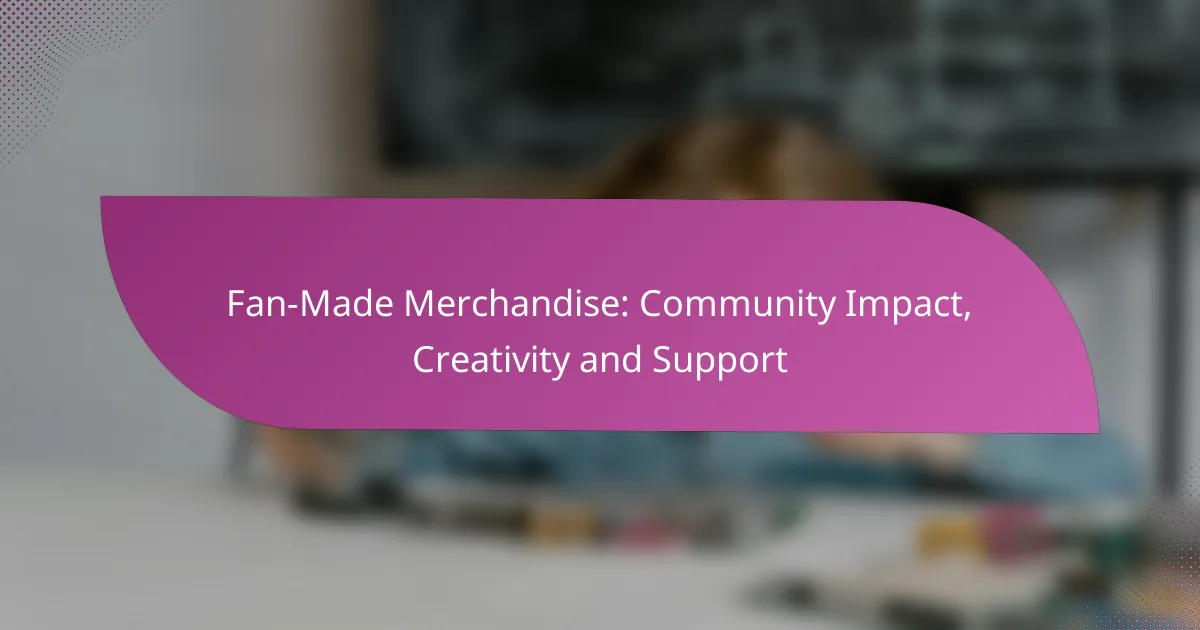Fan-made merchandise plays a vital role in strengthening community bonds, enhancing creativity, and supporting local economies. By allowing fans to express their passions and collaborate, these products not only enrich the fan experience but also foster a supportive environment where creators can thrive. Through shared creations and mutual promotion, fans contribute to a vibrant community that celebrates creativity and connection.
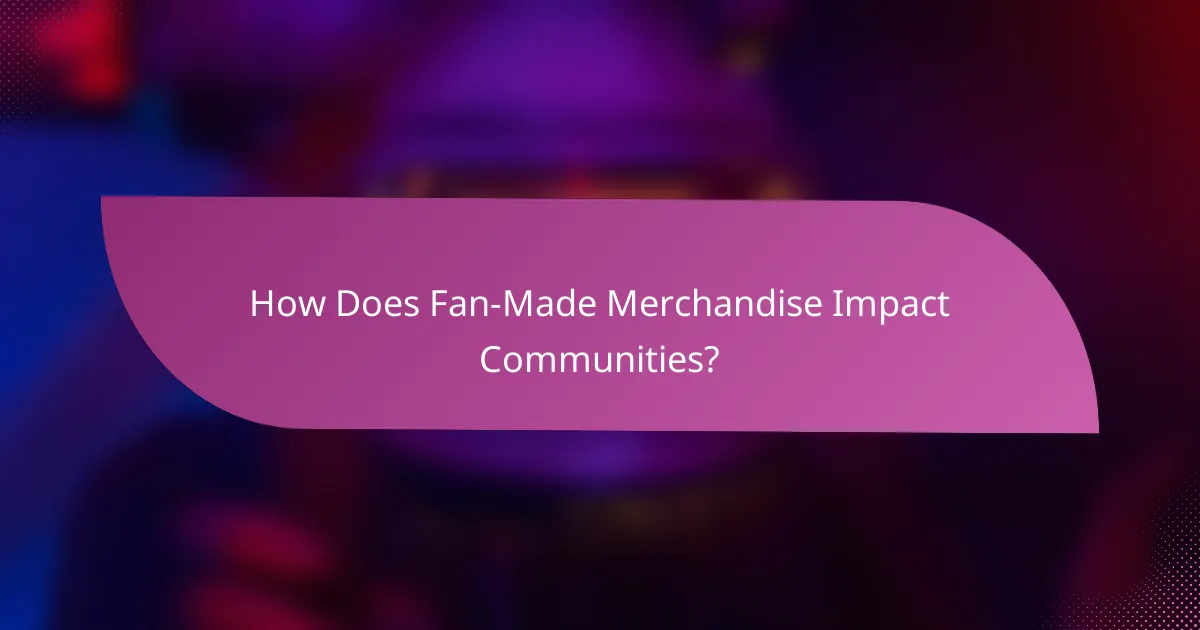
How Does Fan-Made Merchandise Impact Communities?
Fan-made merchandise significantly impacts communities by fostering connections among fans, boosting local economies, and encouraging creativity. This type of merchandise not only reflects the passions of fans but also strengthens the social fabric within communities.
Strengthens community bonds
Fan-made merchandise brings people together by creating shared experiences and interests. When fans collaborate on projects or purchase items that represent their fandom, they often engage in discussions and activities that deepen their connections.
For example, local fan conventions often feature booths for fan-made products, allowing creators and consumers to interact directly. This interaction can lead to friendships and a sense of belonging within the community.
Supports local economies
By purchasing fan-made merchandise, fans contribute to local economies, particularly when creators are based in their area. This spending helps sustain small businesses and independent artists who rely on community support.
For instance, a local artist selling custom t-shirts at a community event not only earns income but also attracts more visitors to the area, benefiting other local shops and services.
Encourages collaboration
Fan-made merchandise often involves collaboration among fans, artists, and creators. This teamwork can lead to innovative products that reflect diverse perspectives and skills.
For example, a group of fans might collaborate on a graphic novel, combining their artistic and storytelling talents. Such projects can enhance the quality of the merchandise and foster a sense of community ownership.
Fosters creativity
The creation of fan-made merchandise encourages individuals to express their creativity. Fans often experiment with different materials, designs, and concepts, leading to unique products that stand out in the market.
Workshops and online platforms where fans can share their creations further stimulate this creative environment. Fans can learn from each other and refine their skills, contributing to a vibrant artistic community.
Enhances fan engagement
Fan-made merchandise enhances engagement by allowing fans to actively participate in their fandom. Instead of passively consuming content, fans can create and share their interpretations, deepening their connection to the source material.
Social media platforms serve as excellent venues for showcasing fan-made items, where creators can receive feedback and build a following. This interaction not only promotes the merchandise but also strengthens the overall fan community.
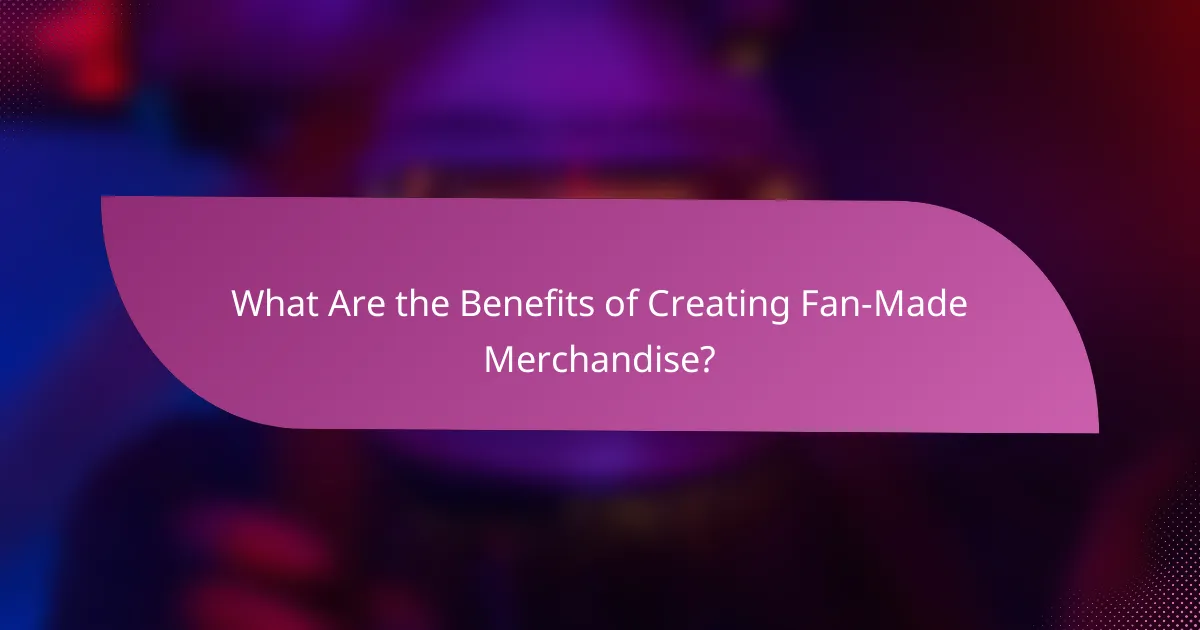
What Are the Benefits of Creating Fan-Made Merchandise?
Creating fan-made merchandise offers numerous advantages, including fostering community engagement and allowing individual creators to express their creativity. These products not only enhance the fan experience but also provide opportunities for financial support within the community.
Empowers individual creators
Fan-made merchandise empowers individual creators by giving them a platform to showcase their artistic talents. This can include anything from custom apparel to unique art prints, allowing creators to express their passion and connect with like-minded fans.
Moreover, creators can gain recognition within their communities, which can lead to further opportunities, such as collaborations or commissions. This empowerment encourages a vibrant ecosystem of creativity and innovation among fans.
Provides unique products
Fan-made merchandise often features unique designs and concepts that are not available through official channels. This uniqueness appeals to fans looking for something special that reflects their personal tastes and fandoms.
For example, a fan might create a limited edition t-shirt featuring a popular quote or artwork that resonates with the community. Such products can become collectibles, enhancing their value and desirability among fellow fans.
Generates revenue for fans
Creating and selling fan-made merchandise can generate revenue for fans, providing a financial incentive to pursue their creative passions. Many creators sell their products through online platforms, allowing them to reach a wider audience and maximize their earnings.
Revenue can vary significantly based on factors such as product type, quality, and marketing efforts. Some creators may earn a few hundred dollars, while others could achieve thousands, especially if their products gain popularity within the fan community.
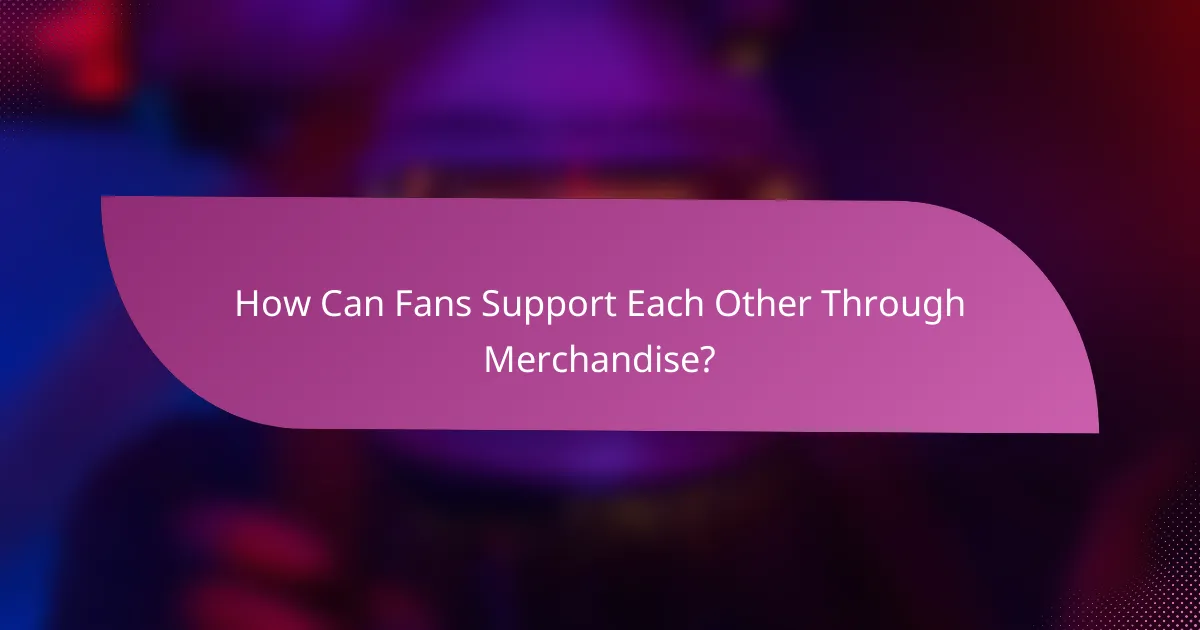
How Can Fans Support Each Other Through Merchandise?
Fans can support each other through merchandise by sharing their creations, promoting one another’s work, and collaborating on projects. This mutual support fosters a vibrant community and enhances creativity while providing financial benefits to creators.
Sharing resources and tools
Sharing resources and tools is essential for fans looking to create merchandise. This can include anything from design software recommendations to printing services that offer discounts for bulk orders. By pooling knowledge and resources, fans can reduce costs and improve the quality of their products.
For example, a fan might share a list of reliable suppliers for custom apparel or provide tutorials on graphic design software. This collaborative approach not only saves time and money but also builds stronger connections within the community.
Promoting each other’s work
Promoting each other’s work is a powerful way to boost visibility and sales for fan-made merchandise. Fans can use social media platforms to showcase their peers’ creations, share links to online shops, and participate in community events. This kind of promotion can significantly increase reach and engagement.
Consider hosting joint giveaways or featuring each other’s products in blog posts or videos. By actively supporting one another, fans can create a network of advocates that amplifies their collective impact.
Collaborative projects
Collaborative projects allow fans to combine their talents and resources to create unique merchandise. This could involve co-designing a product, organizing a themed collection, or even creating a community-driven art book. Such projects not only result in innovative items but also strengthen community bonds.
When embarking on a collaborative project, it’s crucial to establish clear roles and responsibilities. Setting deadlines and communicating regularly can help ensure that the project stays on track and meets the expectations of all involved. Examples include a group of fans creating a limited-edition t-shirt line that reflects their shared interests.
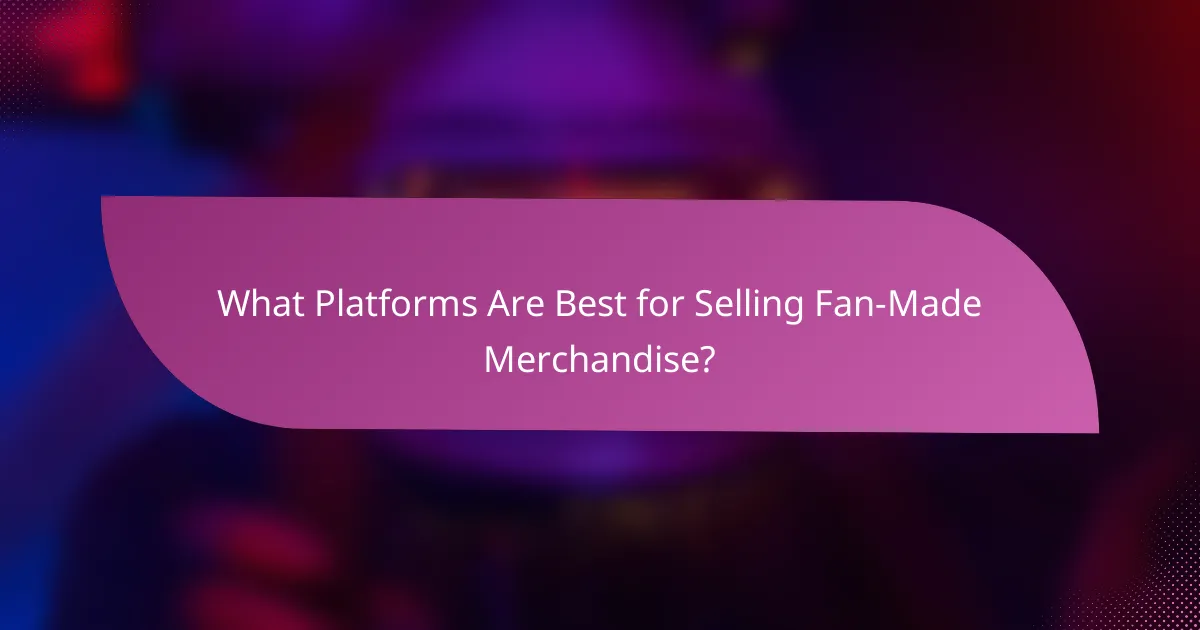
What Platforms Are Best for Selling Fan-Made Merchandise?
Several platforms cater specifically to selling fan-made merchandise, each with unique features and benefits. Choosing the right one depends on the type of products you want to sell and your target audience.
Etsy for handmade items
Etsy is a popular platform for selling handmade and unique items, making it ideal for fan-made merchandise that requires a personal touch. Sellers can create their own shops, list products, and connect with a community of buyers who appreciate craftsmanship.
When using Etsy, consider the fees associated with listing items and transaction costs, which can add up. It’s essential to present high-quality images and detailed descriptions to attract buyers.
Redbubble for print-on-demand
Redbubble specializes in print-on-demand products, allowing artists to upload designs that can be printed on various items like stickers, phone cases, and apparel. This platform is excellent for those who want to sell fan art without managing inventory.
One key advantage of Redbubble is its global reach, as it handles production and shipping, freeing up your time. However, keep in mind that the profit margins can be lower compared to selling directly, as Redbubble takes a percentage of each sale.
Teespring for custom apparel
Teespring, now known as Spring, focuses on custom apparel and merchandise, making it a great choice for fan-made clothing. Users can create and sell shirts, hoodies, and other apparel with their designs, often without upfront costs.
Teespring offers tools for marketing and promoting your products, which can help increase visibility. However, be aware of the production times and shipping costs, as these can affect customer satisfaction and your overall sales strategy.

What Legal Considerations Should Creators Keep in Mind?
Creators of fan-made merchandise must navigate various legal considerations to avoid infringing on intellectual property rights. Understanding copyright, trademark, and licensing agreements is essential for ensuring that their creations are both creative and compliant.
Copyright issues
Copyright protects original works of authorship, including art, music, and written content. When creating fan-made merchandise, it’s crucial to determine whether the original work is protected by copyright and if your use qualifies as fair use. Fair use typically allows limited use for purposes like commentary or criticism, but the boundaries can be ambiguous.
Creators should consider seeking permission from the original copyright holder, especially if the merchandise is intended for commercial sale. This can help avoid potential legal disputes and ensure respect for the original creator’s rights.
Trademark considerations
Trademarks protect brand identifiers such as logos, names, and slogans. Using a trademarked name or logo without permission can lead to infringement claims. It’s important for creators to research whether the elements they wish to use are trademarked and to understand the implications of trademark law.
To minimize risk, creators should avoid using trademarks in a way that could confuse consumers about the source of the merchandise. If in doubt, consider consulting a legal expert to clarify the use of any trademarks in your designs.
Licensing agreements
Licensing agreements allow creators to use copyrighted or trademarked materials legally, usually in exchange for a fee or royalty. Many companies offer licensing options for fan merchandise, which can provide a clear path to legally create and sell products based on their intellectual property.
Before entering a licensing agreement, creators should carefully review the terms, including any restrictions on how the merchandise can be used or marketed. This ensures that the creator’s vision aligns with the rights granted and avoids potential conflicts down the line.
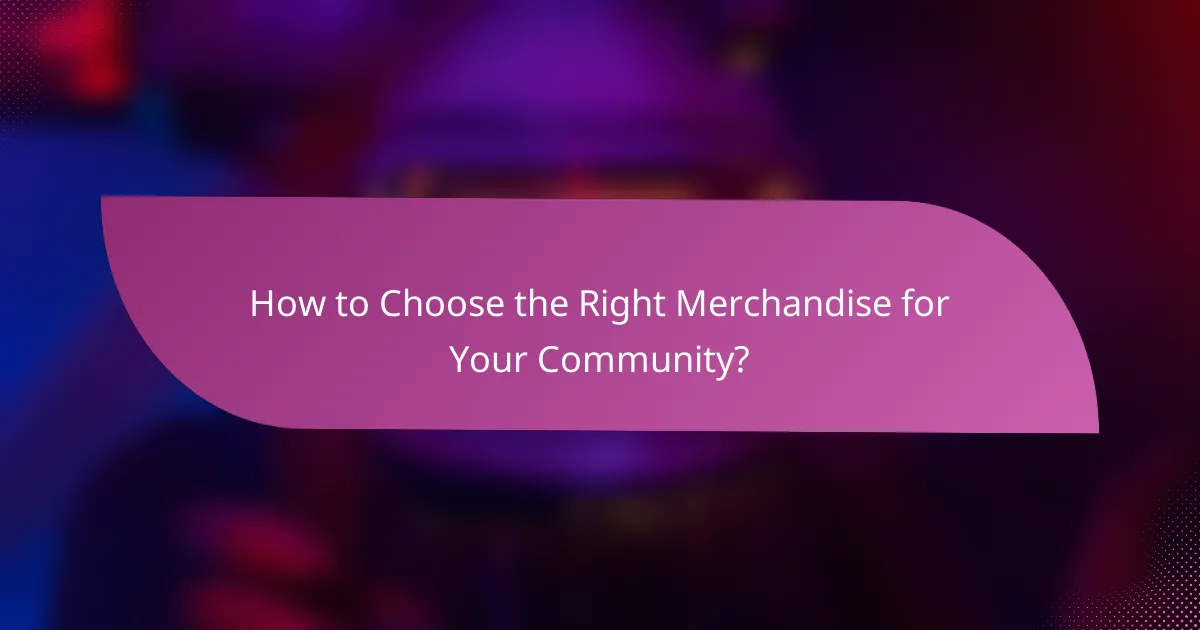
How to Choose the Right Merchandise for Your Community?
Selecting the right merchandise for your community involves understanding its interests, values, and preferences. Focus on items that resonate with the community’s identity and foster a sense of belonging.
Understand Your Community’s Interests
Begin by engaging with community members to gauge their interests and preferences. Surveys, polls, or informal discussions can provide valuable insights into what types of merchandise would be well-received.
Consider popular themes or trends within the community. For example, if your community is passionate about a specific hobby or cause, merchandise related to that topic is likely to be more appealing.
Consider Quality and Pricing
Quality is crucial when selecting merchandise, as it reflects the community’s values. Aim for products that are durable and well-made, even if they come at a slightly higher price point.
Pricing should be reasonable and accessible for the majority of community members. Consider offering a range of price points to accommodate different budgets, ensuring that everyone can participate in supporting the community.
Incorporate Local Elements
Including local elements in your merchandise can enhance its appeal. This could mean using local artists for designs or incorporating local landmarks and symbols into the products.
Highlighting local culture not only supports local talent but also fosters a stronger connection among community members. For example, a community in Bulgaria might feature traditional motifs or colors in their merchandise.
Promote and Distribute Effectively
Once you’ve selected your merchandise, effective promotion is key. Utilize social media, community events, and local partnerships to spread the word and generate interest.
Distribution should be convenient for community members. Consider online sales, local pop-up shops, or community events where people can purchase items directly, enhancing accessibility and engagement.
